#bioconcrete
Text
Bio-Concrete Manufacturing Plant Project: 5 Amazing Key Elements
0 notes
Text
https://heyhey.icu/blogs/5968/Exploring-the-Growing-Trends-in-the-Bioconcrete-Market-Innovations-and
0 notes
Text
Natural Materials: Algae, the Marine Bioconcrete Alternative?
Algae have been some of the most intensively researched organisms for innovative technologies ever. From their potential as a biofuel to fertiliser, nutritional supplements or pollution treatment, the next great promise for these photosynthetic marine organisms is in construction materials.
The Future of Algae Solutions
It is too soon to make any clear predictions on the future of algae construction materials as there is no large-scale production but there is certainly huge promise. Algae is fast to grow, doesn’t use up agricultural land, sequesters carbon, has high recyclability potential and seems to offer impressive structural properties when compared to standard concrete.
The fact that algae construction solutions are mostly SCM-based, bodes well for their future. SCMs are becoming very popular in the construction industry as they allow a material to share the similar useful properties of traditional concrete yet also be low carbon too. Concrete has been notoriously hard to replace since it boasts such impressive strength and durability yet is infamously harmful to the planet, accounting for up to 8% of global GHG emissions.
The creation of low-carbon SCMs seems to hold the key to lowering the colossal emissions of the concrete industry and is being used to achieve a range of sustainable concrete products such as Olivine concrete.
Algae products are already a multi-billion dollar industry, that is expected to grow rapidly. Most of these products are not construction-based, but this means that there is already mass algae cultivation for which to lay the foundation of large-scale algae materials production.
The future of Algae construction seems poised for success and this Biobased low carbon material is greatly needed by the concrete industry that is aiming to be net zero by 2050.
For more updates on sustainable construction visit the Firstplanit Blog page or to discover other sustainable materials and how they impact the environment, explore our material library.
Learn More on Firstplanit
Click here to read about other natural materials making their mark in the construction industry.
#Product Impact Index#Product Benefit Index#Innovative Digital Platform for Building Products#Building decisions made sustainable#Building decisions made resource efficient
0 notes
Link
For each construction project, from the structure of bridges and subterranean parking garages to the foundation of skyscrapers, concrete is still one of the primary materials employed.
Due to its ease of use and long-term durability, concrete building is a regularly used option worldwide. But in addition to its numerous advantages, particularly in the building industry, it also has a lot of disadvantages. That is why self-healing concrete is of much importance.
Importance of Self-healing concrete
Although concrete is the most crucial building material for the construction industry, many concrete structures have had various forms of cracking issues throughout the course of their lifetimes.
Because water enters into ordinary concrete and begins to degrade it and corrode the steel reinforcement, little cracks appearing on the surface of the concrete give the impression that the entire building is susceptible.
This substantially reduces the lifespan or durability of any construction. Concrete can sustain compressive forces quite well, but not tensile forces, which is a well-known fact. Steel reinforcement is used to support concrete structures and resist tensile stresses because when concrete is subjected to tensile tension, it begins to crack.
Marine structures and subterranean basements are two examples of buildings constructed in high-water environments that are particularly susceptible to corrosion of the steel reinforcing. Because salts used to de-ice the roads seep into the gaps in the structures and can speed up the corrosion of steel reinforcing, bridges are also susceptible to corrosion issues.
Tensile pressures may cause cracks in the majority of civil engineering structures, and they can appear quite soon after the building is built.
By using a concrete mortar that is adhered to the damaged surface, traditional concrete structures may be repaired. Metal pins may occasionally need to be used to secure the mortar to the old structure's fissures in order to prevent it from separating.
As repair work is sometimes quite challenging, it takes a long time and costs a lot of money. If the repairs are underground or higher up, it can require more effort to get into the building.
Read more
0 notes
Link
It’s a blog about self-healing concrete
2 notes
·
View notes
Text
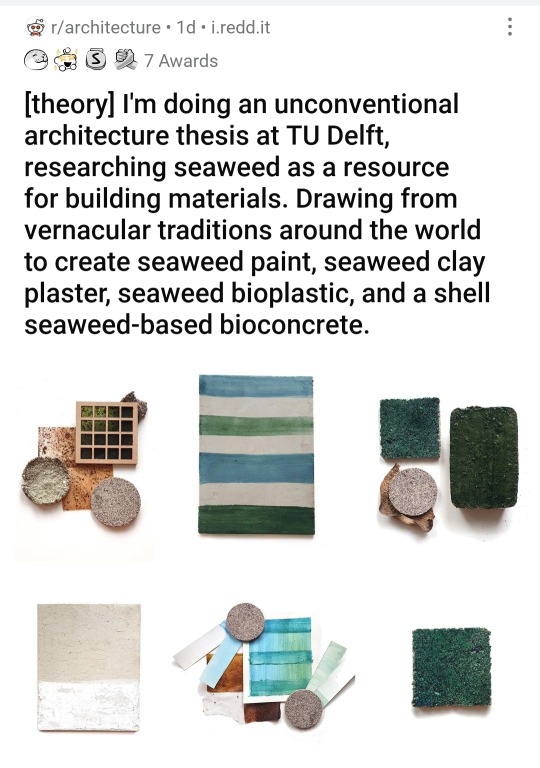


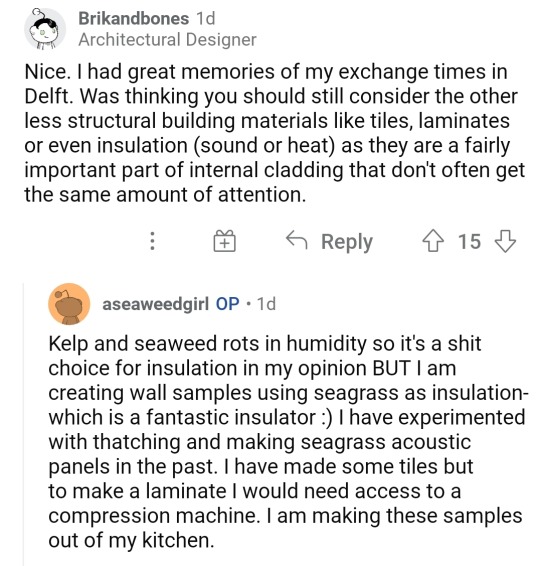

IDs: screenshots of a reddit post and comments on r/architecture. Full Reddit thread can be found here. The title says:
"[theory] I'm doing an unconventional architecture thesis at TU Delft, researching seaweed as a resource for building materials. Drawing from vernacular traditions around the world to create seaweed paint, seaweed clay plaster, seaweed bioplastic, and a shell seaweed-based bioconcrete. "
More info, and eventually her thesis, will be available on her website :
An example of her youtube content :
youtube
294 notes
·
View notes
Text
Professor Clove's Pokemon Trivia!
An Applin a day keeps the doctor away.
Kind of.
Applin is an interesting Pokemon, especially where the type of apple it inhabits determines what it becomes. But did you also know that the nectar it produces has a couple other applications?
Firstly, the nectar it produces is either very sweet or very tart, and right off the bat can have very different uses. The sweeter it is, the more likely it is to be gathered and then mixed into foods like honey would be, whether for baking or other culinary uses. However, the more sour it is, the better at fighting off sickness. Unfortunately, cooking sour nectar results in a denatured version of itself that really isn't good for culinary use at all. However, it can be mixed into warm, not hot, tea and you can obtain many of it's benefits!
Secondly, both nectars can easily be utilized in the crafting of perfumes, colognes, and even beard products like the ones I use! The distillation of the scent can also result in available oils for use in aromatherapy, candles, and other scented things!
Finally, the nectar can be mixed with in with special mucilaginous herbs to create a spreadable bandaid that quickly seals small wounds and helps disinfect them. It's also a key ingredient in the bioconcrete I use for shelled pokemon, along with requisite minerals and Ditto saliva (the only medicinal use I've found for Ditto). The bioconcrete hardens when exposed to oxygen, disinfects the wound and then subtly shifts with the Pokemon's DNA so the body doesn't reject it. Cool, huh!
So many uses for one such small Pokemon!

9 notes
·
View notes
Photo

Living crust -------------------- #biocementation #bacteria #pasteurii #bioconcrete #thesis #biodesign (at Fab Lab Reykjavik)
0 notes
Text
Top Tips for Choosing the Best Concrete Contractor in Austin, Tx

Are you looking for a concrete contractor in Austin, Texas but do not know where to start? Then this article will come in handy for you. There are several concrete contractors in Austin that you can choose from, that is for sure. This is regardless of what you are looking for, that is either for concrete repair or concrete driveway repair, or fresh concrete paving, among so many more. The only question will be; have you chosen the one that can capture your brief well? Many of the choices there are can work on commercial, state, residential, and city projects. Some are better equipped to handle one or two while some can have the capacity to deliver well on any project presented to them. To find the best one for your project, it is best to consider a couple of things first. Here are some top tips for choosing the best asphalt contractor Austin TX.
It is best to start by doing a little research first as this is the most assured way of reaching a well-informed choice. You should identify a few of the most reputable choices there are first so that you can evaluate them further. Another quick way to find a few reputable choices near you is by way of referrals so ask around for some references. These two ways may alienate some great concrete contractors who are breaking into the market so ensure that you have looked closer to see if there may be some that are near you and can still deliver high quality services. Use the websites to find out more about the services.
Find out more about the reputation of the asphalt paving Austin TX contractor as well. To do this effortlessly, go through the reviews and feedback sections to see what their other clients have to say in regards to the services that they offer.
Consider the cost of services too. Here you will have to get a free estimate online first so that you can do a cost comparison. This is the best way to find one that charges a reasonable price.
Check if the concrete contractor has the experience to handle and deliver on such projects. One that has worked on similar projects already has the expertise, skills, and knowledge on how it can be done efficiently.
Is the concrete contractor licensed and approved to operate in Austin, Tx? Find out more about this. For you to get high-quality services, the contractor must be compliant as well and the only way to be sure of this is through licensing. For further details regarding asphalt paving, visit https://edition.cnn.com/2015/05/14/tech/bioconcrete-delft-jonkers/index.html.
1 note
·
View note
Text
Indispensable Use in Cement & Steel Production to Benefit Global Limestone Consumption Against the Backdrop of Recovering Construction Activity
Recovering construction activity and the resulting increase in cement and steel production, coupled with established uses in diverse applications ranging from paper, glass, chemicals, food & beverages to pharmaceuticals manufacturing are poised to drive the global market for Limestone to exceed 5.5 billion tons by 2022.
Limestone is a sedimentary rock found naturally and abundantly across the world. Primarily composed of calcium carbonate (CaCO3), inherited from the ancient remains of marine creatures such as shellfish, Limestone is a rich source of calcium and has seen its use in a range of applications throughout history. Based on its application, limestone can be vaguely categorized as industrial lime, construction lime, chemical lime, refractory lime, and edible lime. Market for limestone, which is used in a range of industrial verticals as filler, additive and purification agent in coarse, fine and ultrafine ground versions, gained immensely from massive expansion in the world industrial manufacturing sector over the years. Cement, steel, paper, and plastics are some of the main application areas for industrial lime.
Spectacular rise in the construction sector, driven by large-scale investments in residential, commercial, institutional, industrial and civil engineering projects, also steered momentum in the world limestone market. Rising demand for agricultural lime, which functions as soil conditioner to improve soil fertility in farm lands; increased food processing activity, where limestone is used as additive; and robust demand for pharmaceuticals, in which it is mainly used as acidity neutralizing agent in heartburn treatments, favored market expansion. Future prospects remain highly favorable amid favorable forecasts for key downstream sectors through the approaching years. Growth trajectory in construction & infrastructure, food processing, pharmaceuticals, agriculture, water treatment, and industrial production would maintain market momentum. Further, emerging applications in novel areas such as self-healing bioconcrete and eco-friendly Portland cement, are poised to enhance limestone consumption.
As stated by the new market research report on Limestone, China represents the largest market worldwide supported by massive investments in the construction sector. Asia-Pacific represents the fastest growing market registering a CAGR of 6.5% over the analysis period. Steady economic growth, positive outlook for the construction industry supported by rising commercial real estate investments and major infrastructure development projects, and high growth application industries such as steel production, cement manufacturing, and glass, metal and paper manufacturing represent key growth drivers in the region.
Key players in the market include Adelaide Brighton Ltd., Atlantic Minerals Limited, Buechel Stone Corp., Carmeuse Group S.A., CRH plc, Elliott Stone Company Inc., Fels-Werke GmbH, Graymont Limited, Grupo Calidra, ILC Resources, Independent Limestone Company LLC, Indiana Limestone Company, LafargeHolcim Ltd., Lhoist Group, Mississippi Lime Company, Mitsubishi Materials Corporation, NALC LLC, Nittetsu Mining Co. Ltd., Schaefer Kalk GmbH & Co KG, Sumitomo Osaka Cement Co. Ltd., Taiheiyo Cement Group, Tarmac, Todaka Mining Co. Ltd., and UBE Material Industries, Ltd. among others.
The research report titled “Limestone: A Global Strategic Business Report” announced by Global Industry Analysts Inc., provides a comprehensive review of market trends, issues, drivers, mergers, acquisitions and other strategic industry activities of major market participants. The report provides market estimates and projections for all major geographic markets such as the United States, Canada, Japan, Europe (France, Germany, Italy, UK, Spain, Russia, and Rest of Europe), China, Asia-Pacific (India, and Rest of Asia-Pacific), Latin America (Brazil, Mexico, and Rest of Latin America), and Rest of World.
For enquiries e-mail us at [email protected] or [email protected].
For cutting edge analyst reviews on top industries
Follow us on Twitter; Connect with us on LinkedIn; Follow us on Medium
3 notes
·
View notes
Text
Bioconcrete or Self-healing Concrete to Repair Cracks -BuildersMART
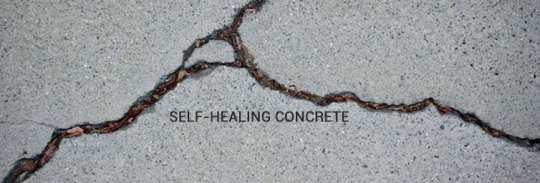
Self-healing concrete is nothing but concrete which can retain itself to the original state when it is subjected to cracks. Know more about Bioconcrete and its uses.
0 notes
Link
Check out the new PlanSwift blog post: Concrete that Repairs itself – Bioconcrete
0 notes
Text
透過添加特殊的真菌,美團隊要讓混凝土能像人一樣受傷後「自我修復」
隨著使用時間一長,混凝土建築經常會出現微小裂縫,而這些裂縫便是許多問題的來源。如果沒有經過適當處理,這些裂縫往往會進一步發展,最終導致結構問題及昂貴的維修費用。
但如果混凝土的裂縫能自我修復呢?
這並不是空談,過去荷蘭科學家 Henk Jonkers 就曾發明新型態的生物混凝土(Bioconcrete),透過細菌自我修復功能,讓一定程度以下的裂縫都能自我修復,這項研究目前也仍在持續。
如今不只是荷蘭,美國賓漢頓大學(Binghamton University)研究人員近日也開發出一種新型態的混凝土,透過添加特殊的真菌,混凝土在出現裂縫時將能自我修復,團隊相信這將能夠幫助基礎設施上經常出現的修復問題。
團隊成員之一、機械工程系助理教授 Congrui Jin…
View On WordPress
0 notes
Text
My Medicine Bag
So in my medicine bag I hold a wide variety of things. I have a Poffin case, for one. I tend to have them made way ahead of time, especially as encountering wild Pokemon food can usually be used as a way to signify peace. There's usually no more than 10 or 15 at a time.
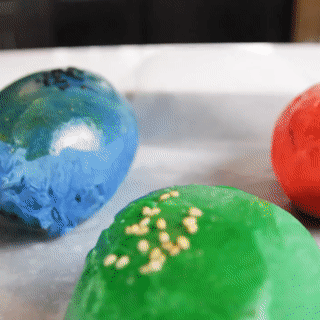
I also hold a tube of bioconcrete, which is made by using Applin nectar mixed with mucilaginous herbs like plantain leaf and slippery elm, along with Ditto saliva. Because this is only the base of the bioconcrete, I have many vials of various powdered substances in there such as iron, silica or ground seashell to help match the type of material I need to patch up. The hard shells of Pokemon such as Drednaw require basically any rock, or something like the Kingler I've been helping out would require the ground seashell. Each one is clearly labeled so I don't mess them up in a rush.
In addition, I have various balms and salves for different things. For example, I have an aloe vera based salve for sunburns, Tropius balm for poisons or skin issues, a Bug repellant kind that uses citronella and garlic (it smells but it works). I also carry various dried herbs to make teas, washes and poultices. There's also literally tons of bandages and bandaids in there of various kinds. You never know when you might encounter a giant Pokemon in the field and you don't wanna run out of bandages.
I also carry a small vial of Shuckle Culture from Leon. It appears like little off-white granules or grainss. I can make a quick probiotic drink in about an hour (though it's not as potent) using mixed herbs and berries. After I make the probiotic, I usually filter the grains and let them dry so I can store more of them, but for my bag I carry just one off doses.

I also carry various field surgeons tools, such as hemostats, scalpels, needle and thread. Emergency surgery may warrant you having the right tools. Plus, I carry latex gloves and alcohol pads when I need to create sterile environment.
And lastly I carry both fresh berries AND various medicines. Berries only work when consumed by Pokemon, or changed into a medicinal state. However, I also have actual medicines like Burn Heals and Antidotes. Sometimes you have to treat right away when the Pokemon is unable to consume the item needed for it's recovery. Plus, I like to have the medicines there's cuz I know Conks won't eat those on a whim.
So that's about it. It's usually quite a lot but I've got strong shoulders, so I can manage. Besides, the little inconvenience I have with this somewhat heavy bag is nothing compared to making sure a Pokemon gets the right care in a flash.

3 notes
·
View notes
Photo
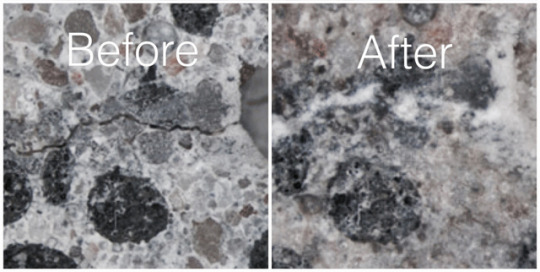
Bioconcrete- A revolutionary way of repairing cracks in building……🏚🏚🏚 Concrete is the most common building material in the whole world, and indeed a long-lasting one. But it’s not indestructible, and when it cracks under pressure from, for instance, change in temperature, air or moisture, it’s both dangerous as well as expensive to fix.
0 notes